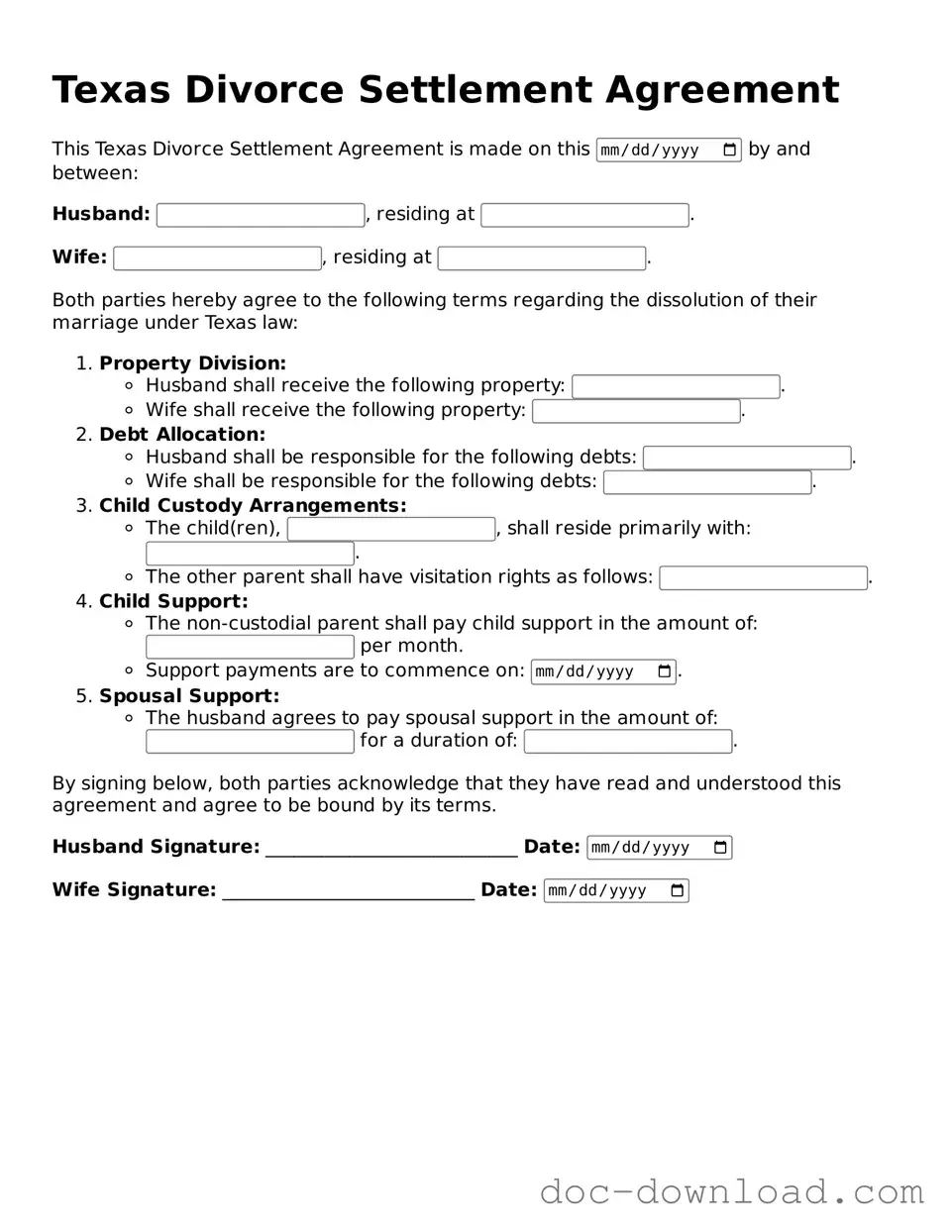The Texas Divorce Settlement Agreement form shares similarities with the Marital Settlement Agreement. Both documents outline the terms agreed upon by spouses regarding the division of property, child custody, and support obligations. They serve as a formalized record of the couple's decisions, ensuring clarity and reducing potential disputes in the future. The Marital Settlement Agreement is often used in various states, reflecting similar principles of negotiation and mutual consent.
Another document akin to the Texas Divorce Settlement Agreement is the Separation Agreement. This document is used when couples decide to live apart but are not yet ready to divorce. Like the Divorce Settlement Agreement, it addresses issues such as asset division, child custody, and spousal support. The Separation Agreement can later be incorporated into the divorce process, making it a practical tool for couples transitioning out of marriage.
The Child Custody Agreement is also comparable. This document focuses specifically on the arrangements for children following a divorce. It details custody arrangements, visitation schedules, and responsibilities of each parent. While the Divorce Settlement Agreement encompasses broader issues, the Child Custody Agreement hones in on the welfare of the children, ensuring their needs are prioritized during and after the divorce process.
The Property Settlement Agreement is another related document. It specifically addresses the division of marital property and debts. This agreement is critical in ensuring that both parties understand their rights and obligations regarding shared assets. It can be used independently or as part of a larger Divorce Settlement Agreement, providing clarity on financial matters post-divorce.
The Parenting Plan is similar in that it outlines how parents will raise their children after separation or divorce. It includes details on education, healthcare, and extracurricular activities. While the Child Custody Agreement focuses on custody and visitation, the Parenting Plan provides a more comprehensive approach to co-parenting, ensuring both parents remain involved in their children’s lives.
The Alimony Agreement parallels the Texas Divorce Settlement Agreement by specifying the terms of spousal support. It details the amount, duration, and conditions under which support is to be paid. This agreement is crucial for ensuring that one spouse receives financial assistance during the transition to single life, reflecting the financial realities of the marriage.
Understanding the nuances of various legal documents is critical for couples navigating separation and divorce. For instance, one must be aware of the implications of using forms like the Texas Divorce Settlement Agreement and how they relate to other documents, such as the Colorado PDF Forms, which serve essential roles in legal proceedings and ensuring all parties have a clear understanding of their rights and obligations.
The Confidentiality Agreement can also be seen as similar in certain contexts. This document ensures that both parties agree to keep sensitive information private, particularly in divorce cases involving high-profile individuals or significant assets. While it does not address custody or property division, it protects the interests of both parties by preventing the public disclosure of personal matters.
The Settlement Conference Agreement is another document that shares common ground. This agreement is often reached during mediation or settlement conferences, where both parties negotiate terms before going to court. It serves as a preliminary agreement that outlines the discussed terms, which can later be formalized in a Divorce Settlement Agreement.
Finally, the Final Judgment of Divorce is closely related, as it is the official court document that finalizes the divorce. It incorporates all agreements made by the parties, including those in the Divorce Settlement Agreement. While the Divorce Settlement Agreement outlines the terms, the Final Judgment serves as the legal confirmation of those terms, making it an essential part of the divorce process.
